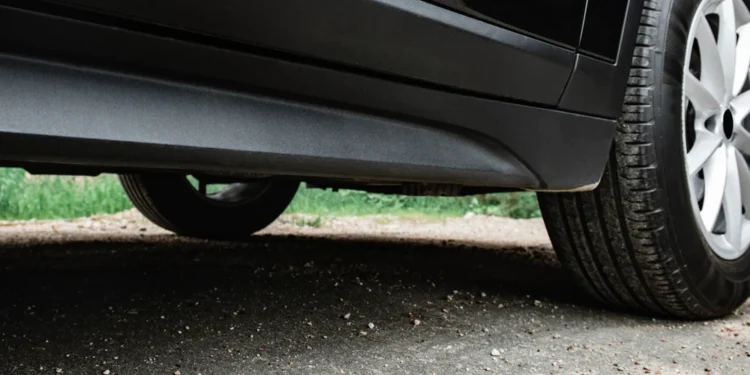Raising a car’s ground clearance improves off-road capabilities and protects the undercarriage—but it also has trade-offs. Here’s everything Ugandan drivers need to know.
If you drive in Uganda, especially in areas outside major towns like Kampala, you already know our roads can be a challenge. From potholes in city streets to rocky rural paths and seasonal floods, the terrain isn’t always friendly. This makes ground clearance—a vehicle’s height from the road to its underbody—one of the most important factors to consider.
So, what happens when your car doesn’t sit high enough? Can raising the ground clearance solve your problems? Is it safe? Let’s dig deep into this topic.
What Does Ground Clearance Really Mean?
Ground clearance, also called ride height, refers to the distance between the lowest point of your vehicle’s underbody and the ground. This space determines how easily a car can drive over obstacles like bumps, rocks, and rough terrain without scraping or damaging parts underneath.
For example:
- SUVs and pickup trucks often have a ground clearance of 200mm or more.
- Sedans and hatchbacks, on the other hand, usually sit closer to the ground, around 120mm to 160mm.
In a Ugandan context, where rural roads, steep driveways, and unpaved stretches are common, a higher ride height offers clear advantages—but not without consequences.
Why Drivers Raise Their Cars
There are a variety of reasons people consider raising their car’s ground clearance:
- To handle rough roads better
- To prevent scraping when loaded with cargo or passengers
- For off-road use and overlanding
- To install larger tyres
- For visual aesthetics—making the car look sportier or rugged
Let’s explore each in detail.
1. Navigating Rough Roads
Uganda’s infrastructure is improving, but many areas still suffer from rough patches, especially during the rainy season. A car with low clearance will likely hit rocks or bottom out in potholes. This can lead to serious damage to the exhaust system, oil pan, or even the suspension.
Raising your vehicle gives you better clearance to glide over these challenges. You won’t have to take weird angles at speed bumps or cringe each time your car dips into a pothole.
2. Handling Heavy Loads
Every car has a designated Gross Vehicle Weight Rating (GVWR), which limits how much weight it can carry safely. However, even within this limit, adding passengers, luggage, or cargo can cause a low-sitting car to sag further—especially at the rear.
By slightly raising the suspension or upgrading to heavy-duty springs or shocks, you can preserve your ground clearance even when your car is fully loaded.
3. Off-Roading Potential
If you enjoy weekend escapes to places like Lake Mburo, Queen Elizabeth National Park, or even the far-flung hills of Kabale, you’ll need a car that can handle dirt trails, mud, and unpredictable inclines.
Higher ground clearance enhances approach, break-over, and departure angles—technical terms that describe how steep a slope your car can tackle without scraping.
Many 4WD vehicles already come with decent clearance, but adventurers often opt to go higher with lift kits for added safety and capability.
4. Bigger Tyres, Better Grip
Some drivers want to fit larger tyres for better grip, higher durability, and a more aggressive look. However, this modification often requires raising the suspension or body to avoid tyre rub on the wheel wells.
Larger tyres also give your car extra ground clearance indirectly, but they may affect speedometer readings and fuel efficiency if not carefully matched.
To browse tyre-compatible cars and see what local options are available, check out Auto24 Uganda, where you’ll find listings for off-road-ready vehicles with suitable specs for Uganda’s terrain.
5. Just for the Looks?
Let’s be honest—some people simply want their car to look tougher. A slightly raised sedan or crossover with bold tyres and blacked-out rims gives a sporty or “rally” vibe. While the functionality may be secondary, the aesthetic transformation can be impressive.
However, form should follow function. Raising a car just for looks without ensuring balance and safety can lead to problems, as we’ll discuss below.
Risks and Drawbacks of Raising Ground Clearance
Before heading to a mechanic for a lift kit or coil spring spacers, consider these downsides:
1. Higher Center of Gravity = Reduced Stability
One of the biggest concerns with increasing ride height is that you raise the car’s center of gravity. This can make your car more prone to body roll, especially in corners. Sudden turns at high speeds become riskier, and emergency handling may be compromised.
This is particularly true if the modification is poorly done or if you lift a car model that wasn’t designed for such height.
2. Suspension and Steering Issues
Lifting the suspension affects more than just the springs—it alters your car’s steering geometry, including:
- Camber and caster angles
- Tie rod length
- Axle alignment
If not adjusted properly, this can lead to uneven tyre wear, poor handling, and even long-term damage to suspension components.
3. Reduced Fuel Economy
When you lift a car and add bigger tyres, you increase wind resistance and rolling resistance. This can lead to a noticeable drop in fuel efficiency—something to consider in Uganda where fuel costs are always a concern for daily drivers.
4. Void Manufacturer Warranty
If your car is still under warranty, lifting it—even slightly—could void coverage for suspension or drivetrain components. Always check with your vehicle manufacturer or dealership before modifying.
5. Legal and Insurance Issues
While Uganda doesn’t currently have strict modification laws like some countries, lifting your car drastically can raise eyebrows during inspections or affect your insurance policy. It’s wise to consult your insurer beforehand.
How Can You Safely Raise Ground Clearance?
If you’ve weighed the pros and cons and decided to go ahead, here are safe ways to increase ground clearance:
1. Install a Suspension Lift Kit
These kits replace or modify your vehicle’s shocks, springs, and other suspension components. They come in different sizes, from mild (1-2 inches) to extreme (4+ inches).
2. Use Coil Spring Spacers
These are cost-effective and relatively easy to install. They sit on top of or inside existing springs to give a modest lift (usually up to 2 inches).
3. Upgrade to Heavy-Duty Springs
If your goal is to prevent sagging under load, upgrading to stiffer or heavy-duty springs will help without drastically affecting stability.
4. Fit Taller Tyres
By changing your tyre size from, say, 195/60R15 to 205/70R15, you gain a few millimeters of extra clearance. Just make sure the tyres don’t interfere with suspension or body panels.
Costs Involved in Uganda
A professional lift job in Uganda can cost between UGX 400,000 to UGX 1,500,000 depending on the vehicle, lift height, and components used. Labour charges and quality of parts also affect pricing.
You can source vehicles that are already lifted or off-road capable from platforms like CarKibanda or Auto24 Uganda, which also feature reviews and price comparisons.
Real-World Alternatives
Sometimes, you don’t need a lift kit at all. You can:
- Simply drive more carefully over bumps and potholes.
- Install underbody protection plates to shield vital parts.
- Opt for a used SUV or crossover if your sedan is giving you too much trouble—automag.ug often features articles that compare such models.
Frequently Asked Questions (FAQs)
1. Is raising my car legal in Uganda?
Yes, there are no strict laws against it currently, but consult your insurance provider and have the job done professionally to avoid safety or legal issues.
2. Will raising ground clearance affect my car’s fuel consumption?
Yes, slightly. Especially if you lift the car significantly or add larger tyres, you may notice a drop in fuel economy.
3. Can any car be lifted?
Technically yes, but it’s easier and safer on SUVs and 4WDs. Small hatchbacks or sedans might suffer more handling issues after a lift.
4. How much ground clearance is good for Uganda?
At least 170mm for daily driving and 200mm or more for rural or off-road routes.
5. Can I raise my car at home?
Basic lifts like coil spacers can be installed with tools, but suspension lifts should always be handled by qualified mechanics.
6. Will raising my car improve resale value?
Not necessarily. Some buyers may see it as a plus, but others may worry about stability or misuse. It’s best to keep receipts and records of any modification.
Final Thoughts
Raising your car’s ground clearance can transform how you experience Uganda’s roads—from smoother travel over potholes to confident adventures off the beaten path. However, it’s not a one-size-fits-all solution. Weigh the pros and cons, understand the technical impacts, and most importantly—do it right.
Whether you’re looking to lift your current vehicle or shop for a model already built for our roads, platforms like auto24.ug and carkibanda.com offer excellent starting points.
For more guides and car maintenance tips tailored to Ugandan drivers, visit automag.ug regularly and stay informed.




